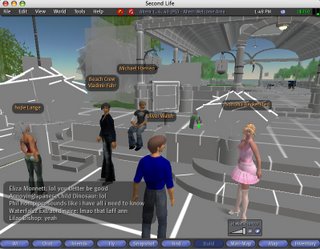
OK, I confess. I watch "Big Brother" on CBS every summer. And with this summer's "All-Star" edition, I won't be giving up this nasty little habit this year either. I always tell my students that it's the perfect environment for a social psychologist--people trapped together for several days with only miminal contact from the outside world. Occasionally something interesting happens on the show that is unpredictable and not under the control of the producers. My colleagues in behavioral neuroscience get to do this kind of thing with their rats and hamsters all the time. In addition, I like reading the TVClubhouse bulletin board, in which fans of the show discuss every aspect of the social drama going on inside the house. (By the way, I'm rooting for Chicken George, who is from one of my hometowns).
The relatively controlled social environment of shows like this is also what attracts me to new developments in virtual environments and other computer simulations. That's why PhD student Alecks Krotoski's Social Sim blog is right up my alley. Among his activities, Alecks is collecting data about social networks formed in Second Life. What is Second Life? A good answer is posted at the website: "Second Life is a 3-D virtual world entirely built and owned by its residents. Since opening to the public in 2003, it has grown explosively and today is inhabited by 321,127 people from around the globe." I have spent a couple of hours on Second Life, but have severely limited my time on there (after all, I already waste three hours a week watching "BB," right?). It's really the next Big Thing in social interaction, and it's ripe with interesting questions to study as a social scientist. It certainly has the capacity to create experimental situations that could be manipulated with random assignment. Someone just has to figure out how to get informed consent from subjects and, of course, IRB approval.
In the meantime my lab group is starting a program of research in immersive virtual environment technology (IVET). Jim Blascovich at UCSB ran an NSF-sponsored summer training program in IVET for three years at his RecVEB, sowing the seeds for what could be an exciting chapter in social psychology. For some great examples of what can be done with this, check out Jeremy Bailenson's lab at Stanford. I'll be reporting on our own lab's work with IVET as it progresses, or you can check out our lab's web site throughout the next few months.

No comments:
Post a Comment